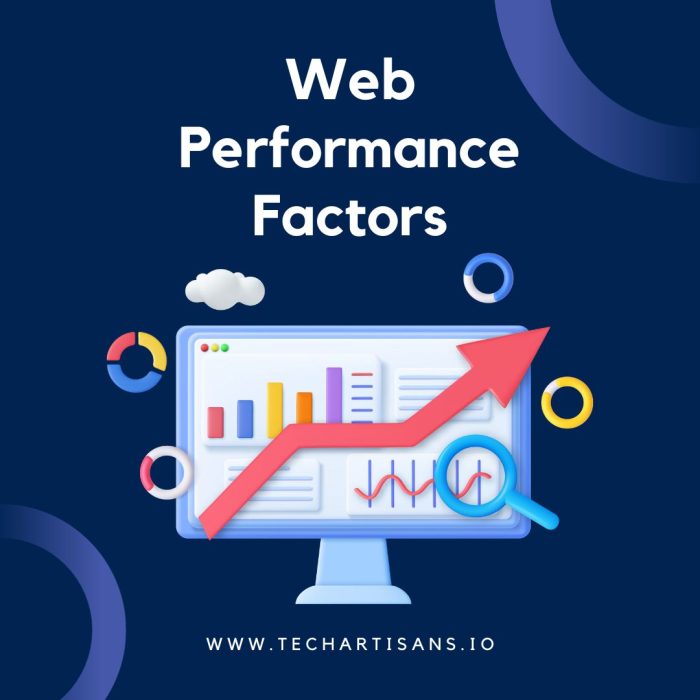In the digital age, web performance is vital for any business’s success. It affects website speed and user experience, ultimately impacting customer satisfaction and sales. Even a small delay can result in lost opportunities. Prioritize website performance optimization for a thriving online presence and future success. In this blog, I have listed several factors that might be affecting your web performance.
Web Performance Basics
The basic idea of improving website performance is to deliver content to users in the fastest, most efficient manner possible. This fundamental understanding includes server speed, JavaScript execution time, and the impact of images and other media files on load time.
1. Key Metrics to Measure Web Performance
Web performance is about how fast web pages load and interact with users. Apart from loading speed, it includes how well a website interacts with visitors, considering factors like response time, render time, and interactivity. Some key metrics to measure web performance include:
a) Load Time
Google’s recommendation is under 2-3 seconds. According to a BBC News report, for each additional second a page takes to load, 10% of users leave.
b) Time to First Byte (TTFB)
Google suggests a TTFB under 200 ms. It’s the time the servers take to respond to a user request, and a lower value signifies an efficient server infrastructure.
c) Start Render
The start render time should ideally be within 1 second. This measures the time taken for the first visual response to appear on the user’s screen after they’ve requested the page.
d) Page Size
The optimal page size is under 500 KB. Larger pages require more resources and take longer to load, negatively impacting user experience and SEO.
Keeping these industry benchmarks in mind while optimizing your website’s performance can ensure you provide an excellent user experience and rank well in search engine results.
2. Web Performance for User Experience and Conversions
Great website performance is vital for a seamless user experience. Fast-loading pages boost engagement and user satisfaction while reducing bounce rates. Also, a well-performing site positively impacts conversion rates in the business, making users more likely to complete actions. Therefore, investing in web performance optimization leads to benefits like enhanced customer loyalty and increased revenue.
Balancing aesthetics and performance in web design is crucial. A visually pleasing website can attract users but it must also be optimized for fast load times and smooth user experience. Efficiency in design techniques, image compression, and minimal use of heavy elements ensure the right balance between aesthetics and functionality for user retention.
Key Factors Affecting Website Performance
There are some key components that impact your website’s speed and performance. Let’s explore each factor to guide your website optimization efforts.
1. Server and Hosting
Your web hosting choice is pivotal for your website’s performance. A quality web host offers reliability and fast access, minimizing downtime and speeding up load times. Server response time plays an important role in page load speed. Factors like high traffic volume and low server capacity can reduce the loading speed.
2. Code Efficiency
Unnecessary or bloated code slows your site, causing longer load times and poor interactivity. Unoptimized images and multimedia content also contribute to this problem.
3. File Types and Sizes
High-resolution images, big videos, and bulky code take longer to load slowing down your website and leading to frustrated users. Therefore, compress files, resize images, and minify code to make your site lighter and faster to improve user experience and business metrics.
4. Mobile Optimization
With more people using smartphones, a mobile-friendly design is a must. Sites not optimized for mobile can be slow and frustrating. Mobile-friendly sites load faster, engage users better, and boost conversions on mobile devices.
5. Content Delivery Networks
Content Delivery Networks (CDNs) boost website performance, especially for distant users. They use servers in different global locations to deliver your site from the closest one, reducing data travel time and speeding up load times. CDNs minimize latency, improve global accessibility, and ensure a smooth user experience.
Tips to Improve Web Performance
Let’s learn practical tips to enhance your website’s performance, ensuring a seamless user experience that retains your audience.
1. Optimizing Images
Boost your website’s speed by optimizing images. Use online tools to compress them, reducing file size without sacrificing quality. Select the right format (JPEG for photos, PNG for transparent images, SVG for icons) for faster loading times.
2. Reducing HTTP Requests
Minimize your website’s load time by understanding HTTP requests. Each element, like images and scripts, triggers a request, slowing down your site. Simplify your design by using CSS, reducing scripts, and consolidating style sheets. Try CSS sprites to combine multiple images into one file, reducing HTTP requests and boosting your website’s speed.
3. Browser Caching
Boost your website’s speed with browser caching. It stores site data on users’ devices, slashing load times and improving user experience for return visits. Save server resources and bandwidth. Implement a cache control header to manage file lifespans effectively and ensure top-notch web performance.
4. Minifying Resources
Minifying resources involves removing unnecessary characters from your HTML, CSS, and JavaScript files. These can include white spaces, line breaks, comments, and block delimiters, which, while improving readability for humans, are not necessary for web browsers and servers. Here are some of the benefits of minifying.
- Minifying your resources can significantly improve web performance.
- It reduces the size of your files, leading to faster load times and a better user experience.
- It reduces the amount of data that needs to be transferred between the server and the client, conserving bandwidth.
5. Improve Code
Keep your code clean and optimized, and use multimedia wisely. Prioritize simplicity and efficiency in your website’s backend to ensure maximum website performance.
6. Robust Hosting
Opt for a robust hosting service to meet your website’s demands effectively.
Tools and Techniques for Monitoring Web Performance
Maximize your website’s potential through effective performance monitoring. Discover the tools and techniques to evaluate your strategies and pinpoint areas for improvement.
1. Google Lighthouse
Google Lighthouse is an automated, open-source tool by Google designed to help developers improve web page quality. It audits for performance, accessibility, progressive web apps, and more. It provides detailed feedback and practical guidance on enhancing webpage performance, making it an invaluable tool for website optimization.
2. GT Metrix
GT Metrix is another powerful tool that gives deep insights into your website’s performance. It examines your web page’s speed using a range of matrices and offers actionable recommendations to improve load times.
How to Interpret the Results and Take Action?
Key metrics like load time, time to first byte, and total page size can reveal where your site is falling behind. The lower these values, the better your website performance is. Translating the insights from these tools into concrete steps such as:
- If load times are long, consider compressing images or minifying resources.
- If the time to first byte is high, server response time could be an issue.
Impact of Web Performance on SEO
Web performance significantly influences SEO as Search engines like Google place high importance on user experience, and a key aspect of this is website speed and performance.
1. Impact of Speed on Search Engine Rankings
Website speed is a critical factor that search engines consider when ranking websites. When Google introduced its “Speed Update” in 2018, it confirmed that page speed is a ranking factor for mobile searches. Fast-loading websites create a better user experience, resulting in lower bounce and higher engagement rates, positively influencing search engine rankings.
2. Impact of Speed on Organic Traffic
Website speed directly impacts organic traffic as users are more likely to stay on and engage with a site that loads quickly. A fast-loading website retains visitors and attracts more organic traffic as search engines favor high-performing sites in their rankings.
3. Web Performance As An SEO Strategy
Effective web performance management should be an integral part of your SEO strategy. Improving site speed, reducing HTTP requests, utilizing browser caching, and minifying resources contribute to better website performance, enhancing your site’s visibility in search engine results and driving more organic traffic.
Case Studies For Improved Web Performance
Let’s delve into various case studies and industry benchmarks highlighting optimized web performance’s immense impact on online businesses’ overall success.
1. Pinterest
Pinterest, the popular visual discovery engine, rebuilt its website for better performance and saw significant improvements. They reduced the wait times by 40% and JavaScript package sizes by 60%, which resulted in a 15% increase in SEO traffic and a 15% increase in conversion rates to signup.
2. The Trainline
The Trainline, a UK-based online ticket sales platform, focused on improving load times to enhance user experience. They reduced latency by just 0.3 seconds, resulting in an additional annual revenue of £8 million. This example clearly shows how even the smallest improvements in web performance can translate into substantial business gains.
3. COOK
COOK, a gourmet frozen food company, changed its website to improve speed and performance. As a result, they saw a 7% increase in conversions, a 7% decrease in bounce rate, and a 50% increase in mobile conversions. It’s a testament to website performance’s role in SEO and driving conversions and business growth.
Conclusion
Prioritizing website performance is essential for online businesses seeking growth. The strong link between web performance, user experience, SEO rankings, and overall success is undeniable. Every effort to enhance website performance, from faster load times to optimized page sizes, offers a significant return on investment. Embrace performance optimization to unlock the multitude of benefits it brings to your business.







